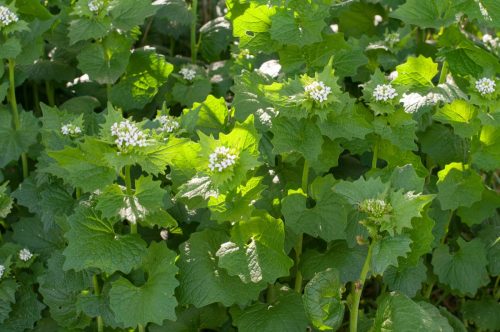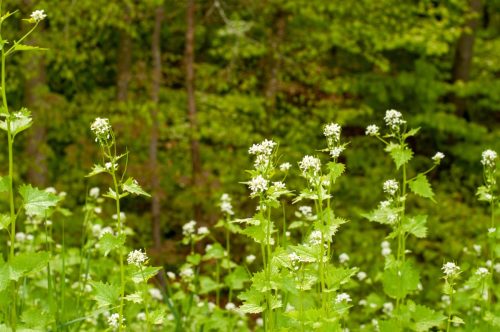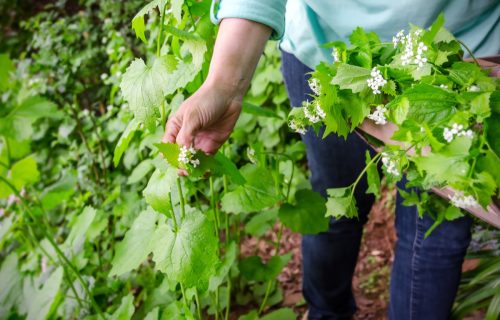If You Spot This Bug, Don’t Kill It—But Report It Immediately, Officials Say

It’s a great time to be outside right now, with the transition to summer finally delivering some warm and sunny weather. Some of us like to spend these months exploring new parks or hiking trails, while others prefer to tend to our own gardens or backyards. In either setting, you unfortunately won’t be alone, as different bugs and other critters also arrive in warmer weather. Now, experts have asked that you keep an eye out for one newly detected insect when you head outside. Read on to find out what bug officials are asking you to report immediately.
READ THIS NEXT: If You See This Scary Bug in Your Home, Don’t Kill It, Experts Warn.
Garlic mustard is an invasive plant species in the U.S.

Garlic mustard is just one of many invasive plants that plague U.S. ecosystems, particularly in the Northeast, Midwest, and Northwest regions. The plant is characterized as “terrestrial invasive” by the U.S. Department of Agriculture (USDA), threatening wildlife around it by crowding out native species. Garlic mustard gets its name from the garlicky smell of its leaves when they are crushed and was originally grown in both Europe and Asia. According to the Nature Conservancy, the plant was thought to have medicinal qualities when cooked and to help soil erosion, but plant experts soon learned garlic mustard’s cons outweighed its pros.
Garlic mustard “requires patience and persistence to get rid of,” the Nature Conservancy says, and the process can take anywhere from two to five years for a specific area. Plant experts debate the effectiveness of pulling out garlic mustard, according to National Geographic, but one insect may be helpful in controlling the spread.
A recently identified bug could be a big help.

Don’t be fooled by the pretty white flowers that adorn garlic mustard, as it sprouts earlier than other plants in order to commandeer sunlight and other natural resources. With no animals that eat it, garlic mustard can spread freely. The issue has gotten so severe that seasonal environmental groups organize pull-a-thons to remove garlic mustard.
“[These plants] can actually prevent saplings from regenerating and other native species from growing in those areas,” Michelle Beloskur, coordinator of the MIPN, told USA Today. “Anytime you have one species dominating, which invasives are really good at doing, you lose biodiversity [and then] habitat for anything else up that food chain.”
But there may be hope for a strategy to contain the plant’s rapid spread. Garlic mustard aphids (Lipaphis alliariae) were identified by staff at Holden Forests and Gardens in Ohio in the summer of 2021, according to an informational flyer from the Midwest Invasive Plant Network (MIPN). Described as “garlic mustard specialists,” these tiny bugs create “twisted seed pods” calls siliques, in addition to a wrinkled effect on leaves.
RELATED: For more up-to-date information, sign up for our daily newsletter.
Experts need help in locating these beneficial insects.

Garlic mustard aphids, also known as grenade aphids, were not recorded in the U.S. prior to 2021, the MIPN said. Because of their potential to assist in controlling garlic mustard, experts are attempting to map their distribution—and they’re asking for your help.
“We’re interested in learning how widespread these aphids might be and learning more about them,” Beloskur told USA Today.
The bugs are black, contrasting the green leaves of garlic mustard, and smaller than two millimeters in size. If you see an aphid on garlic mustard, this is called a positive sighting, whereas seeing garlic mustard without the bug present is called a negative sighting.
Here’s how you can report sightings.

To best assist experts, you can download the EDDMapS app, which is used to map and track invasive species. If you identify a garlic mustard plant (it has a short rosette in the first year of its lifecycle and those white flowers in year two), check for the presence of the garlic mustard aphid. If a critter is crawling on the leaves, report a positive sighting via the app—and be sure to include close-up pictures of the bugs.
If you don’t see any aphids, next check to see if the plant is damaged in any way. You can then report a negative sighting of the aphid, but include a photo of the damaged plant. No bugs or damage to the garlic mustard? Report a negative sighting. Once you’re done, you will want to select actions, then select all, then upload.
If you have any questions about the reporting process, you can contact Rebecah Troutman, natural areas biologist at Holden Forests & Gardens, at [email protected].
READ THIS NEXT: If You Have This Tree in Your Yard, Cut It Down Now, Officials Warn.